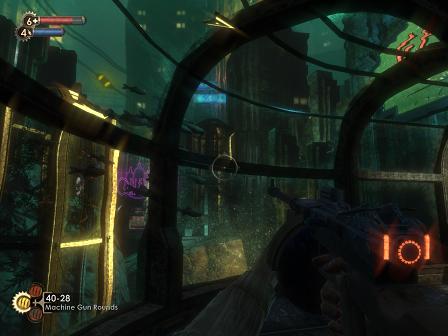Is a man not entitled to the sweat of his own brow? No, says the man in Washington. It belongs to the poor. No, says the man in the Vatican. It belongs to God. No, says the man in Moscow. It belongs to everyone. I rejected these answers. Instead, I chose something different. I chose the impossible. I chose RAPTURE.
– Andrew Ryan, founder of Rapture

Bioshock has been named by multiple sources as the best PC game of 2007, so it was some trepidation that I picked it up, hoping that all the hype wasn’t totally unfounded. As the much heralded spiritual successor of System Shock 2, also written by Ken Levine, Bioshock has always had a lot to live up to, and judging at least by its unexpected commercial success and the near universal acclaim of game critics, it has largely succeeded at that. To me, there’s no question that Bioshock is a pretty much a unique gem, there’s nothing else quite like it in the market, but at the same time, I’m painfully aware that a lot of the hype is undeserved and the thought of what Bioshock could have been, if the designers had just been a little more ambitious and daring, is positively agonizing.
That Bioshock is a triumph of aesthetic design and storytelling goes without question. The opening FMV of the protagonist sitting in a plane, reading a mysterious handwritten message, segues seamlessly into the first scene as the player takes control of the sole survivor of a plane crash in the middle of the Atlantic Ocean. Flames rage on the surface of the ocean as you, confused and exhausted, swim through a gap in the burning debris of the plane to the shelter of a lighthouse that stands, incongruously, on a lonely rock in the middle of nowhere. You push through the gilded double doors and suddenly it’s like walking into a different world. A banner proclaims, “No Gods, No Kings. Only Man”. Music wafts in from an unseen source. Plaques on the walls valourize the virtues of “Art”, “Science” and “Industry”. The grand stairs lead down to a roughly spherical pod sitting in a small pool of water, a bathysphere. You step inside, because there’s nowhere else to go. Then you settle in your seat as it takes you to the bottom of the ocean. The year is 1960. Welcome to Rapture.
Continue reading A Game: Bioshock →